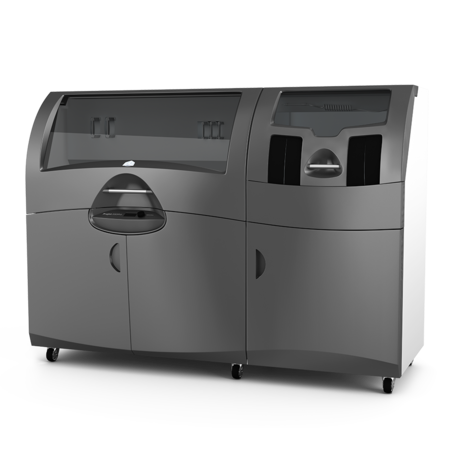“I can see a day when perhaps every department at Durham will have a 3D printer. Being able to quickly and easily turn those 3D designs into physical models using our ProJet CJP 660Pro is fantastic and greatly enhances the research and learning process…” – Dr. Liz Burd, Senior Lecturer in the Department of Computer Science and Deputy Head in the University’s Faculty of Science
A ProJet® 660Pro 3D printer is transforming inter-departmental collaboration at Durham University and is helping the university’s earth scientists to understand the geology and conditions that cause earthquakes in Italy.
The Department of Computer Science at Durham University — at the time England’s only Centre for Excellence in Teaching and Learning in Computer Science — has recently installed a ProJet 660Pro 3D printer.
The ProJet 660Pro is engineered to satisfy the most demanding requirements in engineering, education, AEC, GIS, and entertainment. With the largest build volume of any 3D printer, it enables users to print very large, high-resolution, multicolor models in a few hours or to make many, smaller models at once.
Challenge
Fostering inter-departmental collaboration
On the advice and recommendations of her departmental colleagues, Dr. Liz Burd, senior lecturer in the Department of Computer Science and deputy head in the university’s Faculty of Science, purchased the ProJet 660Pro as a tool that could help facilitate and encourage inter-disciplinary research across many different academic disciplines.
“Part of our research group’s remit is to use the latest computer science and technology to help other departments,” she says, “which is the main reason why we purchased the ProJet 660Pro. However, when we first installed the machine we struggled to attract the interest of other faculties. People just didn’t seem to understand what we could do for them. Now that we’ve had the opportunity to introduce them to the technology and how a 3D model can help them solve their problems, we’ve had many requests for our services.”
Solution
Color Jet printing across multiple departments and applications
One particular, high-profile project currently being undertaken is with the Earth Sciences department. Dr. Ken McCaffrey, reader in Earth Sciences at the university, has created an extraordinary and detailed 3D map of the surface ruptures related to the cataclysmic earthquake that devastated the Italian Apennine region of Abruzzo. The mapping project, part of the wider relief effort reported in the UK national and the international media, is using the ProJet 660Pro to create color, 3D representations of the regional geology. The results of Dr. McCaffrey’s project will, it’s hoped, help to improve the understanding of “quakes, their timing, and likely magnitude.”
Dr. Burd claims that the new ProJet 660Pro is also helping researchers at the university to deal with complexity in a wide variety of other subject areas. By modeling mathematical or physical problems in 3D, she claims, researchers are often better able to understand the nature of a problem. “Computer technologies introduced scientists, researchers, and engineers to 2D programs. Then, after a while, we were able to take models one-step further and use computers to create 3D renderings. Being able to quickly, easily and cheaply turn those 3D renderings into physical models using our ProJet CJP 660Pro is fantastic and greatly enhances the research and learning process, whatever the nature of the application. Since our work with Earth Sciences, and their very public involvement with the Italian earthquake, people in the university are now much more aware of what we have and what we can do to help them with their specific problems.”
The ProJet 660Pro has also been key in the development of a project in collaboration with the RNIB (Royal National Institute for Blind People), creating the 3D mapping of objects to support partially sighted people. Another project is using data collected from an area of coastal cliffs in Southern California. The ProJet 660Pro is being used to create a model of the cliff face, enabling scientists to study fault lines and erosion.
Whatever the project, Dr. Burd describes 3D printing as a “marvel” that people don’t quite believe until they use the technology for themselves. “The ProJet machine is so straight-forward to use,” she says. “You plug it into the office main power supply, download a 3D model from your CAD system and a few minutes later you can have the model in your hand. It’s clean, quiet and it is such a quick and intuitive process that we printed models on the very first day we had the machine.”
Dr. Andrew Hatch is a research associate and a member of the Technology Enhanced Learning Research Group at the university’s Department of Computer Science, working alongside Dr. Burd. It was Dr. Hatch and his departmental colleagues who were charged with researching 3D printing, before recommending what machine would be suitable for the university’s wide variety of possible applications. He began his investigations by researching information through reseller websites, using product descriptions and online videos to help identify their needs, and ultimately, to choose the ProJet 660Pro as the machine most suited to their needs.
Results
The ProJet has enhanced the research and learning process and transformed project collaboration among departments
The ProJet has enhanced the research and learning process and transformed project collaboration among departments Durham’s the ProJet 660Pro has also been introduced and demonstrated to students during university open days and will soon be offered as an integral part of student support. Both Dr. Burd and Dr. Hatch believe that the application of 3D printing will continue to expand across departments and other colleges and universities around the country.
“I can see a day when perhaps every department at Durham will have a 3D printer,” says Dr. Burd.
